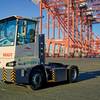Port of Rotterdam, IBM to Build a Connected, Smart Port of the Future
As the largest port in Europe, the Port of Rotterdam handles over 461 million tonnes of cargo and more than 140,000 vessels annually. Previously the port relied on traditional radio and radar communication between captains, pilots, terminal operators, tugboats and more to make key decision on port operations. Now, as the Port of Rotterdam begins its digital transformation, sensors are being installed across 42-kilometers of land and sea - spanning from the City of Rotterdam into the North Sea - along the Port’s quay walls, mooring posts and roads. These sensors will gather multiple data streams including water (hydro) and weather (meteo) data about tides and currents, temperature, wind speed and direction, water levels, berth availability and visibility.
This data will be analyzed by IBM’s cloud-based IoT technologies and turned into information that the Port of Rotterdam can use to make decisions that reduce wait times, determine optimal times for ships to dock, load and unload, and enable more ships into the available space. For example, the Port of Rotterdam will now be able to predict the best time based on water level, to have a ship arrive and depart Rotterdam, ensuring that the maximum amount of cargo is loaded on board.
With the new initiative, Port of Rotterdam operators will also be able to view the operations of all the different parties at the same time, making that process more efficient. In fact, shipping companies and the port stand to save up to one hour in berthing time which can amount to about 80,000 US dollars in savings.
The Port of Rotterdam’s digital transformation project is enabled by IBM’s cloud-based IoT technologies and will see the Port of Rotterdam and IBM are working together long-term to uncover other innovative applications of IoT and artificial intelligence. Cisco and Axians are also involved in the project.














